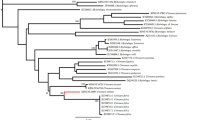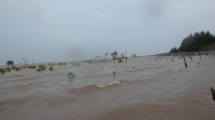Abstract
Phoronida is a phylum of marine invertebrates with a worldwide distribution. Currently, there are 14 species of phoronids in the world fauna, but this number may increase, based on the latest research. In the present study, the morphology and microanatomy of a new phoronid species, Phoronis savinkini sp. n., from the Gulf of Tonkin in the South China Sea are studied. The new phoronid species forms highly dense populations on rocky ground covered with soft sediment at a depth of 2 m. Since the epidermal collar at the base of the tentacles is absent, we refer this species to the genus Phoronis. The lophophore is a one-coil spiral in shape. There are 154 (160) tentacles. Special reproductive glands in the lophophoral cavity are absent. Longitudinal muscle bundles are of the bushy type. The maximum number of bundles is 50. Each metanephridium has a strongly curved excretory canal and two funnels: anal (small) and oral (large). There are two giant nerves of 2–5 μm in diameter. A comparative analysis of the morphological characters used in phoronid taxonomy shows that the morphology of the new phoronid species from the South China Sea seems to be the most similar to that of Phoronis hippocrepia Wright 1856, which has two morphs, one burrowing in hard ground and the other living in soft substrates. However, there are significant morphological differences between the two species: a fundamentally different type of lophophore organization, which is the main taxonomic character in phoronids, a different type of organization of excretory organs (including the structure of the nephridial funnels), and the absence of reproductive glands in the crown of tentacles in the new species. The cladistics analysis of phoronid taxonomic diversity shows that the ecological division of phoronids into two groups (burrowing and living in soft substrates) is meaningful taxonomically as well. Burrowing and digging phoronids might have diverged long ago. The muscle type and the number of branches of the nephridial canal can be considered as the main differences between the two groups. In the present paper, the monophyly of the genus Phoronopsis and the paraphyly of the genus Phoronis are shown. Secondary simplification of Phoronis ovalis is assumed. A separate clade that includes Phoronis pallida and Phoronis embryolabi is suggested.













Similar content being viewed by others
REFERENCES
Ballerstedt, S., Phoronis hippocrepia a horseshoe worm, in Marine Life Information Network: Biology and Sensitivity Key Information Reviews [on–line], Tyler-Walters, H. and Hiscock, K., Eds., Plymouth: Marine Biological Association of the United Kingdom, 2006.
Cohen, B.L., Rerooting the rDNA gene tree reveals phoronids to be ‘brachiopods without shells’; dangers of wide taxon samples in metazoan phylogenetics (Phoronida; Brachiopoda), Zool. J. Linn. Soc., 2013, vol. 167, no. 1, pp. 82–92.
Cori, C.J., Beitrag zur Anatomie der Phoronis, Inaug. Diss. Prague: Univ. Leipzig, 1889.
Emig, C.C., 1974. The systematics and evolution of the phylum Phoronida, Zeitschrift für Zoologische Systematik und Evolutionsforschung, 1974, vol. 12, no. 2, pp. 128–151.
Emig, C.C., Embryology of Phoronida, Am. Zool., 1977, vol. 17, no. 1, pp. 21–37.
Emig, C.C., British and other phoronides, Synops. Brit. Fauna, 1979, vol. 13, pp. 1–57.
Emig, C.C., The biology of Phoronida, Adv. Mar. Biol., 1982, vol. 19, pp. 1–89.
Emig, C.C., On the origin of the Lophophorates, Zeitschrift für Zoologische Systematik und Evolutionsforschung, 1984, vol. 22, no. 2, pp. 91–94.
Emig, C.C., Phylogenetic systematics in Phoronida (Lophophorata), Zeitschrift für Zoologische Systematik und Evolutionsforschung, 1985, vol. 23, no. 3, pp. 184–193.
Emig, C.C., Phoronid@ 2017. Accessed May 15, 2017. http://paleopolis.rediris.es/Phoronida/.
Grobe, P., Larval development, the origin of the coelom and the phylogenetic relationships of the Phoronida, Dissertation, Berlin, Germany: Freie Universität, 2008.
Herrmann, K., Phoronida, Microsc. Anat. Invertebr., 1997, vol. 13, pp. 207–235.
Hilton, W.A., A new Phoronopsis from California, Transact. Am. Microsc. Soc., 1930, vol. 49, pp. 154–159.
Hirose, M., Fukiage, R., Katoh, T., and Kajihara, H., Description and molecular phylogeny of a new species of Phoronis (Phoronida) from Japan, with a redescription of topotypes of P. ijimai Oka, 1897, 1897, ZooKeys, 2014, vol. 398, pp. 1–31.
Jang, K. and Hwang, U., Complete mitochondrial genome of Bugula neritina (Bryozoa, Gymnolaemata, Cheilostomata): phylogenetic position of Bryozoa and phylogeny of lophophorates within the Lophotrochozoa, BMC Genom., 2009, vol. 10, no. 1, pp. 1–18.
Jivaluk, J., Distribution, abundance and composition of zooplankton in the South China Sea, Area I: Gulf of Thailand and East Coast of Pennisular Malaysia, in Proceedings of the First Technical Seminar on Marine Fishery Resource Survey in the South China Sea, Area I: Gulf of Thailand and East Coast of Pennisular Malaysia, 1997, pp. 24–26.
Jivaluk, J., Distribution, abundance and composition of zooplankton in the South China Sea, area II: Sabah, Sarawak and Brunei Darussalam waters, in Proceedings of the Second Technical Seminar on Marine Fishery Resources Survey in the South China Sea, Kuala Lumpur, Malaysia, 1998, pp. 288–309.
Jivaluk, J., Composition, abundance and distribution of zooplankton in the South China Sea, area IV: Vietnamese waters, in Proceeding of the SEAFDEC Seminar on Fishery Resource in the South China Sea, Area IV: Vietnamese Waters, 2000, pp. 77–93.
Kas’yanov, V.L. and Radashevskii, V.I., The first record of phoronids in the waters off Vietnam, Biol. Morya, 1987, no. 4, pp. 69–70.
Kocot, K.M., Struck, T.H., Merkel, J., Waits, D.S., Todt, Ch., Brannock, P.M., et al., Phylogenomics of Lophotrochozoa with consideration of systematic error, Syst. Biol., 2017, vol. 66, no. 2, pp. 256–282.
Mamkaev, Yu.V., On phoronids of Far-Eastern Seas, Issled. Dal’nevost. Morei SSSR, 1962, vol. 8, pp. 219–237.
Nei, M. and Kumar, S., Molecular Evolution and Phylogenetics, Oxford: Oxford Univ. Press, 2000.
Nesnidal, M.P., Helmkampf, M., Meyer, A., Witek, A., Bruchhaus, I., Ebersberger, I., et al., New phylogenomic data support the monophyly of Lophophorata and an Ectoproct–Phoronid clade and indicate that Polyzoa and Kryptrochozoa are caused by systematic bias, BMC Evol. Biol., 2013, vol. 13, no. 253, pp. 1–13.
Omelyanenko, V.A and Kulikova, V.A., Pelagic larvae of benthic invertebrates of the Vostok Bay, Peter the Great Bay, Sea of Japan: composition, phenology, and population dynamics, Russ. J. Mar. Biol., 2011, vol. 37, no. 1, pp. 7–22.
Santagata, S. and Cohen, B.L., Phoronid phylogenetics (Brachiopoda; Phoronata): evidence from morphological cladistics, small and large subunit rDNA sequences, and mitochondrial cox1, Zool. J. Linn. Soc., 2009, vol. 157, no. 1, pp. 34–50.
Selys-Longchamps, M., Über Phoronis und Actinotrocha bei Helgoland, Wissenschaftliche Meeresuntersuchungen, Helgoland, 2003, vol. 6, pp. 1–55.
Silén, L., Researches on Phoronidea of the Gullmar Fiord area (west coast of Sweden), Arkiv Zool., 1952, vol. 4, no. 4, pp. 95–140.
Silén, L., Developmental biology of Phoronidea of the Gullmar Fiord area (west coast of Sweden), Acta Zool., 1954, vol. 35, no. 3, pp. 215–257.
Silén, L., On the Nervous System of Phoronis, Almqvist and Wiksell, 1954a.
Temereva, E.N., A new species of phoronid Phoronopsis malakhovi (Lophophorata, Phoronida) from the South China Sea, Zool. Zh., 2000, vol. 79, no. 9, pp. 1088–1093.
Temereva, E.N., Phylum Phoronida, in Biota rossiiskikh vod Yaponskogo morya (Biota of the Russian Waters of the Sea of Japan), vol. 3: Brakhiopody i foronidy (Brachiopods and Phoronids), Adrianov, A.V., Ed., Vladivostok: Dal’nauka, 2005, pp. 50–76.
Temereva, E.N., Phoronids: structure, development, world fauna, and phylogeny, Doctoral (Biol.) Dissertation, Moscow: Lomonosov Moscow State University, 2008.
Temereva, E.N., New data on distribution, morphology and taxonomy of phoronid larvae (Phoronida, Lophophorata), Invertebr. Zool., 2009, vol. 6, no. 1, pp. 47–64.
Temereva, E.N., Morphology evidences the lophophorates monophyly: short review of studies on the lophophore innervation, Invertebr. Zool., 2017, vol. 14, no. 1, pp. 85–91.
Temereva, E.N. and Chichvarkhin, A., A new phoronid species, Phoronis embryolabi, with a novel type of development, and consideration of phoronid taxonomy and DNA barcoding, Invertebr. Syst., 2017 vol. 31, pp. 65–84.
Temereva, E.N. and Kosevich, I.A., The nervous system of the lophophore in the ctenostome Amathia gracilis provides insight into the morphology of ancestral ectoprocts and the monophyly of the lophophorates, BMC Evol. Biol., 2016, vol. 16, no. 181, pp. 1–24.
Temereva, E.N. and Malakhov, V.V., A new species of borrowing phoronids Phoronis svetlanae (Lophophorata, Phoronida) from the Sea of Japan, Zool. Zh., 1999, vol. 78, no. 5, pp. 626–630.
Temereva, E.N. and Malakhov, V.V., The organization and origin of the circulatory system of Phoronida (Lophophorata), Dokl. Biol. Sci., 2003, vol. 389, pp. 166–168.
Temereva, E.N. and Malakhov, V.V., On the organization of the lophophore in phoronids (Lophophorata: Phoronida), Russ. J. Mar. Biol., 2009, vol. 35, no. 6, pp. 479–489.
Temereva, E. and Malakhov, V., Embryogenesis in phoronids, Invertebr. Zool., 2012, vol. 8, no. 1, pp. 1–39.
Temereva, E.N. and Neretina, T.V., A distinct phoronid larva: morphological and molecular evidence, Invertebr. Syst., 2013, vol. 27, no. 6, pp. 622–633.
Temereva, E.N. and Tsitrin, E.B., Development and organization of the larval nervous system in Phoronopsis harmeri: new insights into phoronid phylogeny, Front. Zool., 2014, vol. 11, no. 3, pp. 1–25.
Temereva, E. and Tsitrin, E., Modern data on the innervation of the lophophore in Lingula anatina (Brachiopoda) support the monophyly of the lophophorates, PLoS One, 2015, vol. 10, no. 4, pp. 1–29.
Temereva, E.N., Malakhov, V.V., and Chernyshev, A.V., Giant actinotroch, a larva of Phoronida from the South China Sea: the giant larva phenomenon, Dokl. Biol. Sci., 2006, vol. 410, pp. 410–413.
Temereva, E.N., Neretina, T.V., and Stupnikova, A., The fauna of the South China Sea include unknown phoronid species: new records of larvae and adults, Syst. Biodivers., 2016, vol. 14, no. 3, pp. 509–523.
Temereva, E.N., Neretina, T.V., and Stupnikova, A.N., An original description of the larval stages of Phoronis australis Haswell, 1883 and an analysis of the world fauna of phoronid larvae, Russ. J. Mar. Biol., 2016a, vol. 41, no. 2, pp. 128–138.
Vyshkvartsev, D.I., Lebedev, E.B., and Kalashnikov, V.Z., The consequences of the Vera typhoon: beaching invertebrates on the sand bar of the Posieta Bay, Sea of Japan, Biol. Morya, 1990, vol. 5, pp. 78–80.
Wright, T.S., Description of two tubicolar animals, Proc. R. Soc. Edinburgh, 1856, vol. 1, pp. 165–167.
ACKNOWLEDGMENTS
We are grateful to Oleg Savinkin, who provided material for this work. We thank the staff of the laboratory of electron microscopy, Moscow State University, for assistance with electron microscopy studies. The morphological studies were supported by the Russian Foundation for Basic Research (project nos. 17-04-00586 and 15-29-02601), 3D reconstructions were supported by the Russian Science Foundation (project no. 14-14-00262), and cladistic analysis was supported by the Russian Science Foundation (project no. 14-50-00029). The study was performed under the State subject no. АААА-А16-116021660057-5.
Author information
Authors and Affiliations
Corresponding authors
Additional information
Translated by M. Batrukova
Rights and permissions
About this article
Cite this article
Temereva, E.N., Neklyudov, B.V. A New Phoronid Species, Phoronis savinkini sp. n., from the South China Sea and an Analysis of the Taxonomic Diversity of Phoronida. Biol Bull Russ Acad Sci 45, 617–639 (2018). https://doi.org/10.1134/S1062359018070154
Received:
Published:
Issue Date:
DOI: https://doi.org/10.1134/S1062359018070154




